The Origins of the British: The New Prehistory of Britain (65 page)
Read The Origins of the British: The New Prehistory of Britain Online
Authors: Oppenheimer

The only markers available to carry out this refining of the gene groups into further branches are the STR gene types (Single Tandem Repeat sequence haplotypes), which were established for each of the samples in the composite dataset. STR types are less reliable than UEPs for building trees because they are made up of a combination of rapidly mutating genetic sites which can mutate forward and backwards, thus introducing ambiguity. None the less, they are used for this purpose, and their rapid mutation has the advantage of facilitating analysis of shorter time periods.
14
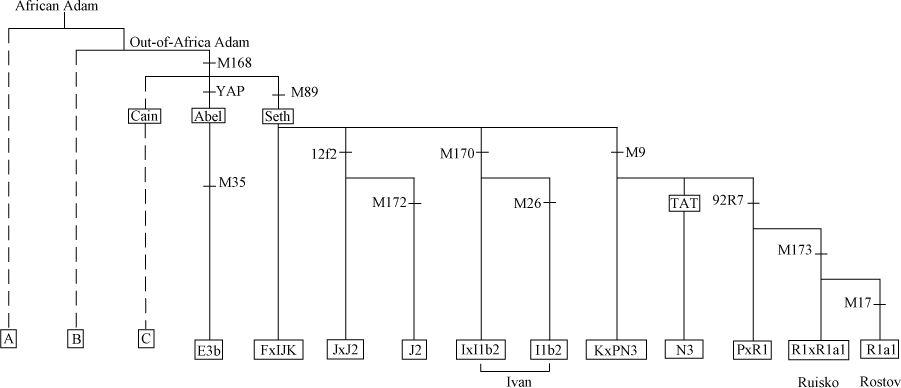
Figure A3
Tree of the main Y-chromosome gene groups (haplogroups) used in the analysis in this book. Gene group boxes for Europe are labelled in consensus nomenclature
5
qualified after Capelli,
11
with relevant nicknames Ruisko, Ivan and Rostov below. These three clusters are expanded respectively in
Figures A4
to
A6
. The dotted lines indicate major world gene groups A, B and C not represented in Europeans; nicknames are shown for the common male ancestor and the three out-of-Africa lines.
8
(Haplogroups are based on ‘unique event polymorphisms’ – labelled horizontal lines along branches; branch length does not represent age.)
After dividing the entire composite dataset of 3,084 into gene groups and sub-groups, I then ranked the haplotypes within each group.
15
As found previously,
16
within each group there were several groups of related gene types clustering around a common or modal haplotype. Capelli, for instance, created three STR-defined clusters of one-step relatives around three of the commoner haplotypes. The difference is that whereas Capelli et al. have chosen only three clusters, thus adding to their eleven UEP-defined haplogroups to make fourteen groups, I have systematically broken up each of the three large haplogroups into clusters in this way, thus adding thirty clusters to eleven haplogroups, making nearly fifty groups including all sub-clusters (
Figures A3
–
A6
). I also performed the same process on the two smaller Neolithic groups J/J2 and E3b, but have not displayed the data as figures here.
I used a standard network software package
17
to confirm the phylogenetic validity of these clusters and date them. This confirmed the integrity of the clusters and suggested a very small number of rearrangements between minor clusters. I have called these derived sub-groups ‘clusters’ rather than subgroups to differentiate them in the text, and identified these clusters within a gene group by inserting the cluster number hyphenated after the gene group name (e.g. R1b-9). In effect, these clusters are ‘putative founding clades’.
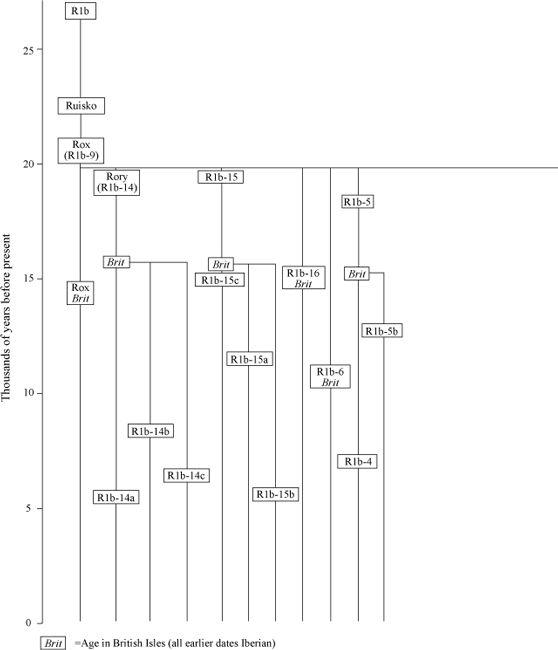
Figure A4
Tree of Ruisko gene clusters described in this book, with branch dates. Two major expansions from the Franco-Spanish refuge are evident: one after the LGM and another after the Younger Dryas. Only R1b-8a expanded in the historical period in the British Isles. (Here and in
Figures A5
and
A6
, cluster labels are located along branches according to approximate age, and subtitled ‘Brit’ if the date of the founding event in the British Isles is substantially different from the overall age of the cluster in Iberia, or the cluster is unique to the British Isles – e.g. cluster R1b-7.)
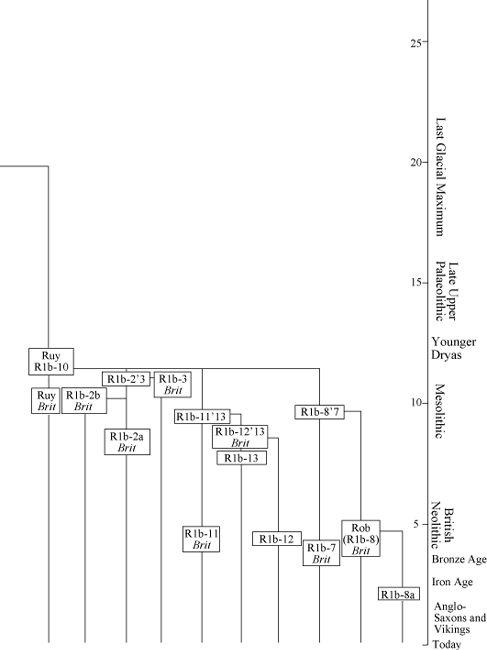
I have also dated each cluster (with the same software), using Forster’s calibration and dating method, which is similar in principle to that used for mitochondrial DNA.
18
The age, number in founding cluster used for dating (
n
), root haplotype and standard deviation for each gene cluster (or gene group) are given where relevant in the notes.
19
The composite dataset with haplotypes and IDs will be available on request after they have been published in a peer-reviewed journal. Pending this, it is possible for individuals to know the exact male cluster they belong to among the nearly fifty shown in this appendix. To obtain this, contact
http://www.ethnoancestry.com
.
I have displayed spatial frequency distributions of gene groups and clusters graphically throughout the text using Surfer 8 Software (Golden Software). This appears rather like modern television displays of weather variables such as temperature, where curved ‘contour lines’ join up areas of similar temperature. Because such displays are easier on the eye than pie charts, they have become the graphics of choice for illustrating such genetic frequency distributions in the literature.
20
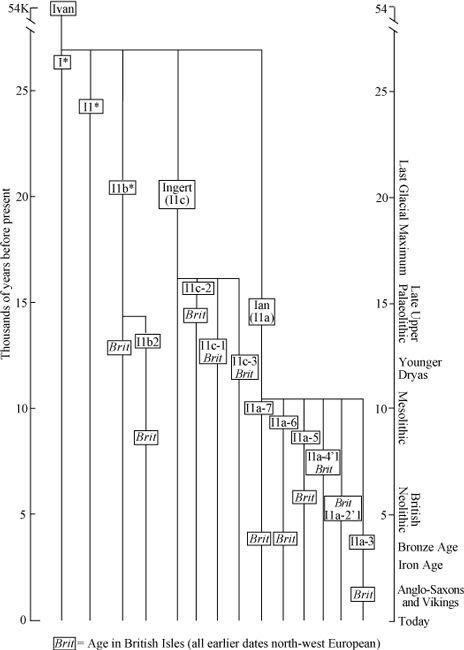
Figure A5
Tree of Ivan gene groups
12
,
13
and clusters described in this book, with branch dates. I1c expanded in north-west Europe during the Late Upper Palaeolithic, but founding events were staggered in Britain later, up to the Mesolithic. I1a1 expanded in north-west Europe during the Mesolithic, but founding events were staggered in Britain later into the Neolithic. Only I1a-3 expanded in the historical period into the British Isles. (Cluster labels as in
Figure A4.
)
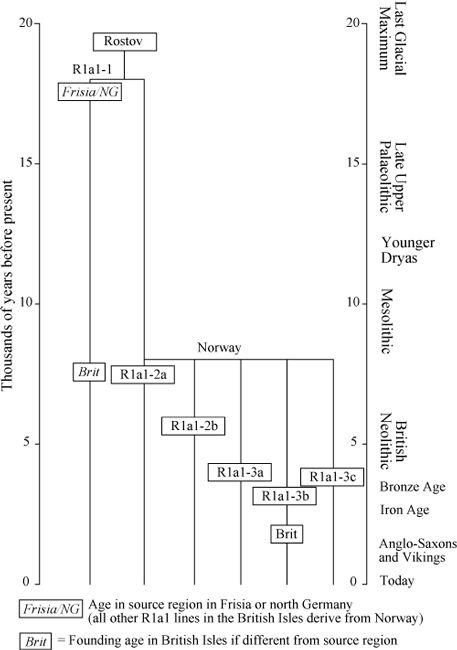
Figure A6
Tree of Rostov gene clusters described in this book, with branch dates. Rostov may have arrived on the North European Plain in the Late Upper Palaeolithic (R1a1-1); this line dates to the Mesolithic in Britain. Other branches of Rostov expanded in Norway during the Late Mesolithic, but founding events were staggered in Britain later, during the Neolithic and Bronze Age. Only R1a1-3b expanded in the historical period into the British Isles. (Cluster labels as in
Figure A4
.)
LOSSARY
A word of warning: terminology is used variably in several of the fields covered in this book. This glossary summarizes the way I have used technical terms. In several instances I have used non-jargon words, to replace jargon, for instance ‘gene type’ for haplotype. Such usage is clarified below. Terms in bold type within a definition have their own entries.
acculturation
The process of adopting a new culture. Shares functional meaning with the less fashionable term ‘cultural diffusion’ (
see
diffusionism
).
allele
One of two or more alternative forms of a gene that occupy the same locus (area) on a chromosome.
All-over-Corded (AOC) Beaker
A type of
bell beaker
decorated all over the surface with twisted cord impressions, found in the Rhine Valley, the Netherlands and the eastern part of the British Isles from the third millennium
BC
.
Atlantic façade (fringe)
In the context of this book, the coastal areas of Western Europe extending from the British Isles to the Iberian Peninsula. In the British Isles, this includes Ireland and the west coast of Britain.
Atlantic Modal Haplotype (AMH)
The most common male STR
haplotype
(gene type) in Western Europe as reported by Wilson et al. (2001) (the root gene type of R1b-10, or Ruy in this book).
See
single tandem repeat
.
bell beaker
A general style of upside-down-bell-shaped pot common to and shared between several cultures of Western Europe and North Africa, in their Late Neolithic and early metal-age phases.
Bronze Age
A period following the
Neolithic
, associated with the use of metal implements made of bronze. In Britain the Bronze Age commenced about 4,500 years ago, and gave way to the
Iron Age
around 1200–800
BC
.
Brythonic
(also ‘Brittonic’, ‘British’ in some historical texts, ‘P-celtic’) A branch of
insular-celtic
languages, including Welsh, Cumbrian, Cornish and Breton.
calibrated dates and calendar years
The level of atmospheric radiocarbon is not strictly constant, so raw radiocarbon dates, often expressed as ‘radiocarbon years before present’, have to be calibrated or corrected using tables to give ‘calendar years ago’. Unless otherwise stated, ‘calendar years ago’ are used for all radiocarbon-derived dates in this book, based on corrections already made in the primary literature sources cited.
